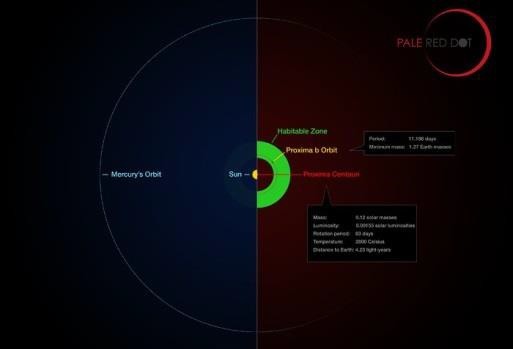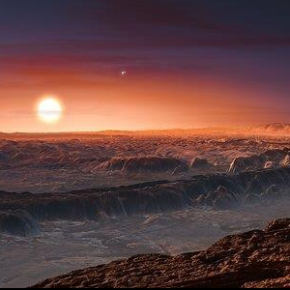
Closest ever exoplanet is potentially habitable
Proxima Centauri, the closest star to the Sun, has a rocky, Earth-sized planet located in the star's habitable zone, where liquid water can exist on the surface. This major discovery was made by an international team of researchers including Julien Morin from the Laboratoire Univers et Particules de Montpellier (CNRS/Université de Montpellier), and is published on 25 August 2016 in Nature .
At the same time, two other teams of astrophysicists and planetary scientists, mostly from France, have carried out an in-depth study of the exoplanet's environment. Although the radiation from its star may have initially stripped away some of the planet's gas, an atmosphere and water may still be present. Under certain conditions, which remain hypothetical, the planet may even harbor liquid water on its surface and have an environment potentially favorable to life. Their findings can be accessed online.
By definition, this is the closest exoplanet to Earth ever discovered: Proxima b orbits around Proxima Centauri, the nearest star to the Sun, a mere 4.2 light years away. What's more, the exoplanet, which was discovered by an international team of researchers, is very probably rocky like our own planet, while its minimum mass is 1.3 times that of the Earth. It is located seven million kilometers from Proxima Centauri, which is 20 times closer than the distance of the Earth from the Sun. However, Proxima Centauri is a red dwarf star and therefore far fainter than our Sun. As a result, Proxima b lies well within the habitable zone and its temperature would allow the presence of liquid water on its surface.
The presence of a planet in orbit around Proxima Centauri had been suspected for years. Its existence has now been confirmed following a two-year research camapign, dubbed 'Pale Red Dot'1
. The campaign was stepped up in the past six months, when the star was monitored by the HARPS spectrograph on ESO's 3.6-meter telescope at La Silla in Chile, the ASH2 telescope at the San Pedro de Atacama Celestial Explorations Observatory (Chile), and the 18 telescopes of the Las Cumbres array. Combined with earlier observations made at ESO observatories and elsewhere, the new observations carried out for 60 nights enabled the researchers to detect a very faint oscillation in Proxima Centauri's radial velocity—a mere 5 kilometers per hour—with a period of 11.2 days, caused by the gravitational attraction of Proxima b, and also allowed them to distinguish this signal from that caused by the star's magnetic activity. Proxima b thus completes one orbit around its host star every 11.2 days. Red dwarfs like Proxima Centauri are active stars and can vary in ways that would mimic the presence of a planet. To rule out this possibility, the team carefully monitored variations in the star's brightness during the campaign using the ASH2 and Las Cumbres Observatory telescopes. (Radial velocity data from HARPS taken when the star was flaring were excluded from the final analysis.)
Since exoplanet detection is a very popular research topic, the 'Pale Red Dot' team set up a website2
dedicated to the project, enabling the general public to follow the progress of the campaign. The campaign reports were accompanied by numerous outreach articles about exoplanets and stellar physics written by specialists from around the world.
The findings, published in Nature, are accompanied by complementary studies of this planetary system. The habitability of the planet, in other words the possibility that it could host liquid water on its surface, was studied by two other mainly French teams including researchers at the Laboratoire d'Astrophysique de Bordeaux (CNRS/Université de Bordeaux) and the Laboratoire de Météorologie Dynamique (CNRS/UPMC/ENS Paris/Ecole Polytechnique). Their papers, which have been submitted to the journal Astronomy & Astrophysics, are available online (see references at the end of this press release).
The first paper concerns the evolution of the star and its planet. The researchers show that, although the planet is today located in the habitable zone, where oceans could exist on its surface, this has not always been the case. During its youth the star was much brighter. As a result, water could not exist in a liquid state on the planet's surface: it was vaporized into a thick atmosphere and exposed to high-energy radiation from its star. The researchers studied the characteristics of this radiation today and found that the planet receives 250 times more X-rays and 15 times more extreme UV than Earth. This strong radiation could have broken up the water molecules and strongly heated the planet's upper atmosphere, leading to a significant loss of water and gas into space. Despite this, the planet may today host a thick atmosphere as well as oceans: it all depends on the quantity of water and gas it received during its formation.
The second paper examines the possible climates of Proxima b, assuming that the planet still has an atmosphere. To do this, the French researchers used a 3D numerical model of planetary climates derived from terrestrial models and adapted to the Proxima star system. Numerous simulations were performed in order to explore the possible range of amounts of water and carbon dioxide present on the planet. They showed that, depending on the planet's spin rate and the amount of greenhouse gases, liquid water may be present across the entire surface of the planet or only in the sunniest regions. If the planet turns out to be poor in water, water could condense and accumulate as ice in the coldest regions as otherwise. However, the atmosphere and the resulting greenhouse heating could melt this water ice, creating lakes and rivers in these areas. Everything also depends on the rotation of the planet, with gravitational forces possibly locking one side in perpetual darkness, like the Moon in orbit around the Earth (see Figure 3).
The authors of the paper also used 3D atmospheric models to simulate and prepare for future observations: the 39-meter E-ELT telescope, under construction in Chile, will in the future be able to 'see' the planet directly, separately from its star, something that is today only possible for gas giants. These observations will tell us whether Proxima b has water, an atmosphere and a habitable climate.
In any case, despite having the potential to host water and harbor life, Proxima b cannot be considered an Earth twin. The history of Proxima b and its star was completely different from that of the Earth and the Sun. The formation of Proxima b, the irradiation from its star, and the tidal forces to which it is subjected and that affect its internal structure and rotation, have no equivalent in the history of our own planet.
In coming years, there will be increasingly frequent observations of rocky planets in orbit around active M-type dwarf stars, as dedicated instruments such as SPIRou (http://spirou.irap.omp.eu/) become operational. This international near-infrared spectropolarimeter, developed by France, is scheduled for first light in 2017 at the Canada-France-Hawaii Telescope (CFHT) on the summit of the Mauna Kea volcano in Hawaii.

© ESO

© ESO/M. Kornmesser/G. Colema

The two cases of rotation thought to be possible for Proxima b are explored:
- in synchronous rotation, like the Moon orbiting the Earth, with one side in perpetual sunlight and the other in
perpetual darkness
- in 3:2 orbital resonance, like Mercury, spinning three times every two orbits.
© LMD
A terrestrial planet candidate in a temperate orbit around Proxima Centauri, by G. Anglada-Escudé et al., Nature, 25 August 2016.
The habitability of Proxima Centauri b: I. Irradiation, rotation and volatile inventory from formation to the present, by Ignasi Ribas et al., www.proximacentauri.info/pdf/Proxima_habitability_I.pdf
The habitability of Proxima Centauri b: II. Possible climates and observability, by Martin Turbet et al, www.proximacentauri.info/pdf/Proxima_habitability_II.pdf


